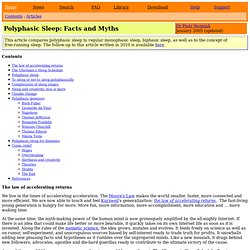

Polyphasic Sleep: Facts and Myths. Contents The law of accelerating returns We live in the times of accelerating acceleration.

The Moore's Law makes the world smaller, faster, more connected and more efficient. We are now able to touch and feel Kurzweil's generalization: the law of accelerating returns . The fast-living young generation is hungry for more. At the same time, the myth-making power of the human mind is now grotesquely amplified by the all-mighty Internet. Around the year 2000, a new meme cropped up in several blogs on the net: The Uberman's Sleep Schedule. The Uberman's Sleep Schedule The idea behind the Uberman's Sleep Schedule is to gain waking hours by sleeping the total of just 3 hours in 6 portions distributed equally throughout the day.
The Uberman's Sleep Schedule was proposed in this blog at Everything2. Polyphasic sleep More and more frequently, Uberman's Sleep Schedule was being referred to as polyphasic sleep (the term popularized by research and book by an Italian chronobiologist Dr. Uberman's sleep schedule. Background The Uberman sleep schedule is a method of organizing your sleeping time to maximize your REM sleep and minimize your non-REM sleep.

The goal of the sleep cycle is that you are actively in REM sleep within a couple of minutes of falling asleep and remain in that state until you awaken. I originally read about the schedule on everything2. In essence, someone utilizing the Uberman sleep schedule is actively modifying their sleeping habits so that they can immediately jump from waking to a few minutes worth of stage 1 sleep straight to stage 5 REM sleep, as described in this discussion of sleep stages. It is important to note that there are no studies as to the long-term physical or physiological impact of this sleep cycle. The Uberman's Sleep Schedule Sleeping Hours The Uberman's sleep schedule revolves around forcing yourself to rely on six twenty to thirty minute naps spread throughout the day for your daily dose of sleep.
Benefits The obvious first benefit is more free time. Leonardo da Vinci e il sonno polifasico: non è necessario dormire una notte di seguito per essere efficienti ma bastano brevi sonnellini ripetuti. Il sonno è un processo che varia durante la vita di un essere umano e passa dal sonno polifasico del neonato a quello bifasico del bambino (che dorme piuttosto a lungo nel pomeriggio), a quello monofasico circadiano, tarato sul ciclo giorno-notte, dell’adulto.

Infine nella senilità il ritmo circadiano, strettamente monofasico del giovane adulto, lascia spazio ad un ritmo polifasico ultradiano, ovvero con frequenti sonnellini diurni. L’aspetto che vorrei evidenziare in questo articolo è quello del sonno polifasico, che è stata una caratteristica predominante nella vita di Leonardo da Vinci, ma anche di Thomas Edison, Buckminster Fuller, Nikola Tesla, Benjamin Franklin, Thomas Jefferson, e Napoleone. La domanda che molti vorranno pormi, sarà, però, la seguente: ma non si diceva che per sentirsi in forma bisogna dormire almeno otto ore per notte? Via Lastknight ho trovato alcune risorse interessanti per approfondire l’argomento: Polyphasic Sleep. A couple days ago, I saw a post about polyphasic sleep on LifeHack.org. Since then I’ve been emailed about this topic as well, probably because I’ve written previously about becoming an early riser. Polyphasic sleep involves taking multiple short sleep periods throughout the day instead of getting all your sleep in one long chunk.
A popular form of polyphasic sleep, the Uberman sleep schedule, suggests that you sleep 20-30 minutes six times per day, with equally spaced naps every 4 hours around the clock. This means you’re only sleeping 2-3 hours per day. I’d previously heard of polyphasic sleep, but until now I hadn’t come across practical schedules that people seem to be reporting interesting results with. Under this sleep schedule, your sleep times might be at 2am, 6am, 10am, 2pm, 6pm, and 10pm. How can this sleep schedule work? It requires some discipline to successfully transition to this cycle, as well as a flexible schedule that allows it.
Plus it’s just plain weird. Sleep well!